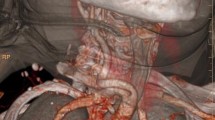Abstract
In order to examine ‘ultrasound’ approach in detecting the course of the vertebral artery (VA) and its anomalies important for neck surgery. An observational study with retrospective analysis of ultrasound images. 500 VAs on 250 3D CT angiographies and 500 ultrasound images performed on the same set of patients were analyzed. The relationship between the extraosseous portions of the VA to the neck organs with a special emphasis to the thyroid gland area, and the abnormal position of the VA were detected. Ultrasound and CT 3D images were compared. Ultrasound detected that 29 out of 500 VAs were anomalous (5.8%), 3D CT detected 30 cases. These anomalies were found in 22 patients (8.8%) (23 for 3D CT; 9.2%), in 7 (31.8%) of them bilaterally. An abnormal level of entrance (C3, C4, and C5) was observed in all anomalous cases. An additional case detected by 3D CT indicated C7 level of entrance. The ultrasound data correspond the CT data in 96.7% of cases. In ten cases (33.3%) the anomalous VA run close to the thyroid gland even touching the lower pole (16.7%; n = 5) or the upper pole (10.0%; n = 3) of the gland. In ten cases (33.3%) the anomalous VA crossed common carotid artery and the internal jugular vein by a way of a median loop. The incidence of anatomic variations of the VA is significant. Preoperative ultrasound investigation allows precise identification of anomalous VAs. Radiation-free ultrasound investigation of blood vessels is as precise as CT 3D imaging.


Similar content being viewed by others
References
Bruneau M, Cornelius JF, Marneffe V et al (2006) Anatomical variations of the V2 segment of the vertebral artery. Neurosurgery 59(1 Suppl 1):ONS20–ONS24
Hong JT, Park DK, Lee MJ et al (2008) Anatomical variations of the vertebral artery segment in the lower cervical spine: analysis by three-dimensional computed tomography angiography. Spine (Phila Pa 1976) 33(22):2422–2426
Brown MW, Templeton AW, Hodges FW III (1964) The incidence of acquired and congenital fusions in the cervical spine. Am J Roentgenol 94:1255–1259
Kowada M, Kikuchi K (1979) Symmetrical extracranial fenestrations of the vertebral artery. Two cases revealed by angiography. Radiology 131(2):408
Sato K, Watanabe T, Yoshimoto T et al (1994) Magnetic resonance imaging of C2 segmental type of vertebral artery. Surg Neurol 41(1):45–51
Tsai FY, Mahon J, Woodruff JV et al (1975) Congenital absence of bilateral vertebral arteries with occipital-basilar anastomosis. Am J Roentgenol Radium Ther Nucl Med 124(2):281–286
Schwarzacher SW, Krammer EB (1989) Complex anomalies of the human aortic arch system: unique case with both vertebral arteries as additional branches of the aortic arch. Anat Rec 225(3):246–250
Tan WS, Spigos DG (1979) Right vertebral artery originating from the right common carotid. Radiologe 19(4):155–156
Sim E, Vaccaro AR, Berzlanovich A et al (2001) Fenestration of the extracranial vertebral artery: review of the literature. Spine 26:139–142
Tokuda K, Miyasaka K, Abe H et al (1985) Anomalous atlantoaxial portions of vertebral and posterior inferior cerebellar arteries. Neuroradiology 27(5):410–413
Berry AD III, Kepes JJ, Wetzel MD (1988) Segmental duplication of the basilar artery with thrombosis. Stroke 19(2):256–260
Trattnig S, Schwaighofer B, Hübsch P et al (1991) Color-coded Doppler sonography of vertebral arteries. J Ultrasound Med 10(4):221–226
Schweizer J, Müller F, Altmann E et al (1990) Doppler sonography in the diagnosis of extracranial vascular changes. Z Gesamte Inn Med 45(20):609–611
Ackerstaff RG, Hoeneveld H, Slowikowski JM et al (1984) Ultrasonic duplex scanning in atherosclerotic disease of the innominate, subclavian and vertebral arteries. A comparative study with angiography. Ultrasound Med Biol 10(4):409–418
Robbins KT (2001) Pocket Guide to neck dissection classification and TNM staging of head and neck cancer, 2nd edn. American Academy of Otolaryngology-Head and Neck Surgery, Alexandria, pp 9–11
Yilmaz E, Celik HH, Durgun B et al (1993) Arteria thyroidea ima arising from the brachiocephalic trunk with bilateral absence of inferior thyroid arteries: a case report. Surg Radiol Anat 15(3):197–199
Conflict of interest
The authors state no potential conflict of interest, no funding, and no other conflicts of any kind. The research was performed without any grant support, honoraria, gifts, and fees of any kind. The authors warrant that the article is original and not under consideration by another publication; and its essential substance and tables have not been previously published. It does not infringe upon any copyright or other proprietary right of any third party, and have not been published previously.
Author information
Authors and Affiliations
Corresponding author
Rights and permissions
About this article
Cite this article
Vaiman, M., Beckerman, I. & Eviatar, E. Detection of anomalous vertebral arteries by ultrasound as an alternative to radiological methods. Eur Arch Otorhinolaryngol 268, 1813–1816 (2011). https://doi.org/10.1007/s00405-011-1549-3
Received:
Accepted:
Published:
Issue Date:
DOI: https://doi.org/10.1007/s00405-011-1549-3




